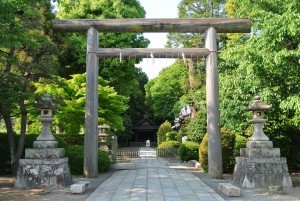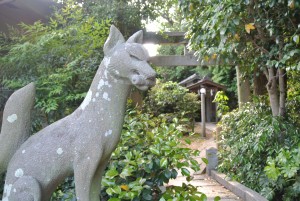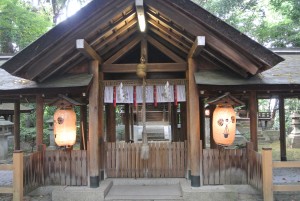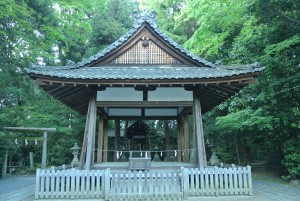
Entrance to Konoshima Jinja, better known as Kaiko no Yashiro (Silkworm Shrine), in the Uzumasa district of Kyoto.
Much about the Hata is shrouded in mystery and lost in time. In which century did they arrive into Japan? Did they come from Korea, from China – or somewhere far beyond that along the Silk Road? What belief systems did they pick up on their trails – Buddhism, Judaism, Korean shamanism, Nestorian Christianity?
The uncertainty has led to some fanciful theories, sparked by the triangular torii that stands to the side of the Worship Hall at Konoshima Jinja. (See next post.) The shrine is known popularly as the Silkworm Shrine or Kaiko no Yashiro, because of a subshrine in the grounds dedicated to the silkworm deity. It was for their work in spreading sericulture in Japan that the Hata are best known.

Through the torii is a section of Inari subshrines, one of which is in a cave-like hollow beneath the ground.
The shrine is a curious affair, well-kept yet always strangely deserted whenever I’ve been there. There is nothing to suggest any interest in visitors, no note to explain when the shrine office is open, no invitation to ring a bell for the priest, and no indication of any goods for sale. Worst of all, in my opinion, the pond is empty of water though a noticeboard boasts of how it shows a connection with nature. (What factors are involved in maintaining the water I’m uncertain.)
My Japanese companion suggested the shrine had made money from selling off land and therefore had no interest in attending to business. Perhaps she’s right. But nonetheless it’s sad that a shrine boasting such a rich heritage should be unprepared to do more for visitors.
As one might expect from a Hata shrine, a section of the grounds is set aside for Inari worship. There is not just one subshrine, but three or four. One of them, unusually, is in a cave-like hollow below ground, as if to suggest a fox’s lair.
Another curious feature is that the pond is called Moto Tadasu no ike (Original Tadasu Pond). Shimogamo Jinja is well known for its Tadasu Woods, but it seems Konoshima Jinja claims to have had the original (tadasu has the sense of atonement, or cleansing negativity through purification). At one time, apparently, there was a surrounding mulberry forest known as ‘Mototadasu-no-Mori’ to feed the silkworms. It suggests some kind of connection between the two shrines.

The Worship Hall (Haiden). Notice the distinctive aoi emblem on the lanterns, usually associated with the Kamo clan.
Another connection with Shimogamo Jinja lies in the use of the aoi emblem. The flower is closely connected with the Kamo clan, who had also settled in the Kyoto basin in pre-Heian times and founded the Kamigamo and Shimogamo Shrines.
At the Aoi Festival every May the plant is used to decorate the costumes of participants, and it is widely used as an emblem at the shrines. It seems at some stage the Hata clan became allied to the Kamo through marriage and adopted the aoi emblem too (Matsuo Taisha also uses it).
But the most intriguing feature of the Konoshima Shrine is undoubtedly the triangular torii that stands to the left of the Worship Hall. Its date and purpose are unknown, but it is closely connected with the Hata. And it’s a subject I’d like to deal with in a separate post. Dear Reader, read on…

The Maiden or Kaguraden is used for performances to entertain the kami. To the left of the picture stands a most unusual three-sided torii.
For Part Four on this series about the Hata clan, please click here.

Leave a Reply